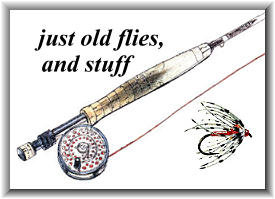It's back to the Rangeley Region of Maine this week, to
a fly called the Allerton, named for R.G. Allerton. Mr.
Allerton owned one of the first large lodges built on
Mooselucmaguntic. He was treasurer of the Oquossoc
Angling Association, and the following was written about him in
Outing Magazine in 1886:
"In eight years, from 1869 to 1876, Mr. R. G. Allerton,
the late owner of Allerton's Lodge, a mile or so above Camp Bemis,
took 1,336, trout, weighing 1,623 pounds. The majority of these were
caught, I believe, by deep fishing with bait. This is largely a question
of patience. Your guide rows you to the spots in the deep water where
he deems the trout most likely to lie during the hot weather. There you
wait, fishing perhaps for a couple of days without a bite, to be finally
rewarded by a few large fish. "
In case you don't completely believe these statistics, I found
them broken down year by year in a Scribner's Magazine article
from 1877:

Here is a sketch of Camp Allerton as it existed in the early days:

Allerton's fly is interesting to me, and I would guess that he was perhaps trying to cover a couple
of bases with its design. I've always wondered about all the blue flies from this era, but I realize
now that they were a response to the blueback trout, forage fish for the large brook trout found
in the Rangeley lakes. The red fin on this fly may have been put there to fuel the cannibalistic
tendencies of the brook trout. Sort of a "two mints in one" approach to fly design, as I see it.
In any case, the fly was no doubt successful judging by R. G. Allerton's results. Here is the recipe:
Allerton
Tip: Gold tinsel
Tail: Teal or barred wood duck
Ribbing: Gold tinsel
Body: Yellow floss
Hackle: Dark blue tied palmer, yellow at shoulder
Wing: Scarlet
Note: Ray Bergman leaves out the yellow shoulder hackle
in this fly. J. Edson Leonard includes it. In the Mary Orvis
Marbury book it doesn't seem to be there, though it's a little
hard to say for sure.
Credits: Trout-Fishing in the Rangeley Lakes by Edward
Seymour, article from Scribner's Monthly Vol. XIII. February, 1877 No. 4;
Richardson and Rangeley Lakes Illustrated by Charles A. J. Farrar;
Flies by J. Edson Leonard; Trout by Ray Bergman;
Favorite Flies and Their Histories by Mary Orvis Marbury;
Outing Volume Vlll Issue 3 June 1886 "Trout Fishing In Maine" by Ripley Hitchcock;
~ EA
About Eric:
 Eric lives in Delaware, Ohio and fishes for brown trout in
the Mad River, a beautiful spring creek. More of his flies
are on display here:
Traditionalflies.com -- Classic salmon and
trout flies of Europe and the Americas.
Eric lives in Delaware, Ohio and fishes for brown trout in
the Mad River, a beautiful spring creek. More of his flies
are on display here:
Traditionalflies.com -- Classic salmon and
trout flies of Europe and the Americas.
|




 Eric lives in Delaware, Ohio and fishes for brown trout in
the Mad River, a beautiful spring creek. More of his flies
are on display here:
Traditionalflies.com -- Classic salmon and
trout flies of Europe and the Americas.
Eric lives in Delaware, Ohio and fishes for brown trout in
the Mad River, a beautiful spring creek. More of his flies
are on display here:
Traditionalflies.com -- Classic salmon and
trout flies of Europe and the Americas.